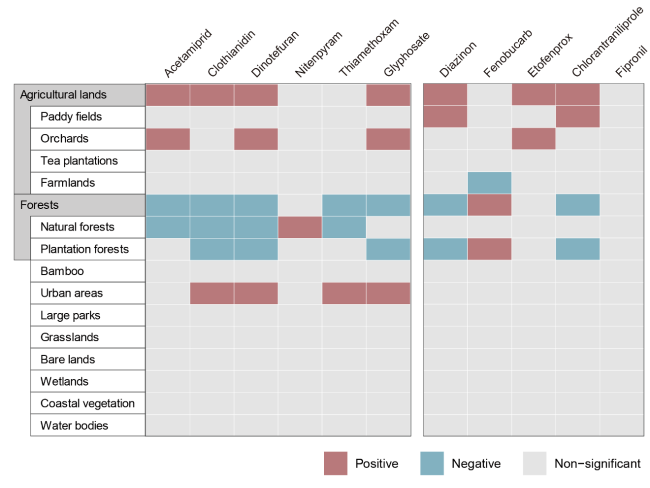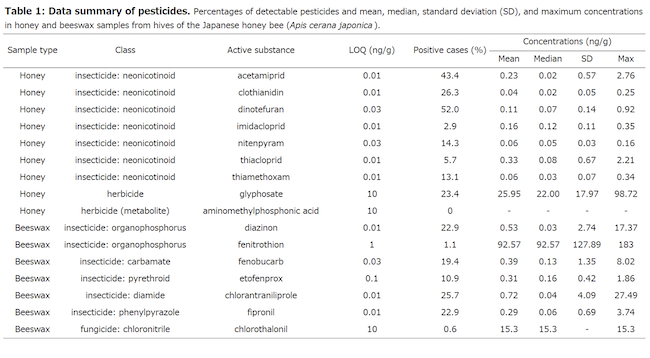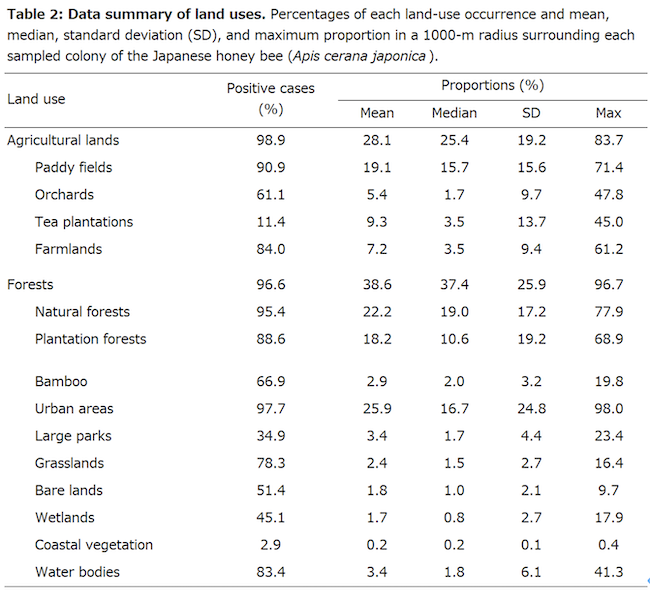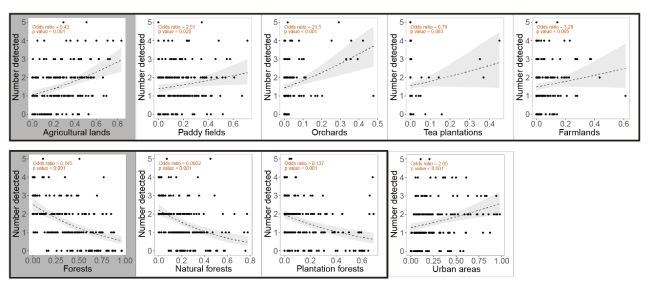The impact of the surrounding environment on the exposure of honey bees to pesticides
These findings are published in the 22 October 2024 issue of the British journal Nature Communications.
Key Points
・This study conducted a citizen science project of unprecedented scale, with samples being collected from Japanese honey bee colonies at 175 locations nationwide. Using ultra-trace pesticide analysis techniques, we were able to measure actual exposure levels to even very low pesticide concentrations of honey bees inhabiting various environments. ・The study showed that the risk of pesticide exposure is high not only in agricultural lands (paddy fields and orchards) but also in urban areas.
1.Background
Bees1 are important pollinators that contribute to the reproductive success of many wild plants and cultivated crops. The recent decline in their numbers is therefore of global concern. Although the decline of bee populations has various causes, pesticide exposure is considered a key risk factor.Bees forage within a certain geographic range, and if they visit an area where pesticides have been applied, they may be directly exposed to pesticides, or they may collect pesticide-contaminated pollen and nectar which they then bring back to the hive. So far, pesticide exposure assessments have focused primarily on single-crop fields treated with specific pesticides. However, in the actual habitats of wild bees, multiple crops are often grown in a patchwork distribution, and bees are likely to be exposed to various pesticides simultaneously. Additionally, because pesticides are used not only in agricultural lands but also in urban and forested environments, bees inhabiting such environments may also be exposed to pesticides.
To identify high-risk habitats and to obtain important information for reducing the exposure of wild bees to pesticides, it is crucial to measure the actual exposure of bees to pesticides in different environments. In this study, we focused on the Japanese honey bee (Apis cerana japonica), a subspecies of the eastern honey bee, and evaluated how the surrounding environment affects the exposure to pesticides of colonies of this species.
2.Methods
From summer to autumn of 2021, we collected honey and beeswax from Japanese honey bee colonies maintained at 175 locations nationwide and analyzed pesticide concentrations to ultra-trace levels. In our analysis, we included only colonies that (1) had started nesting that year, and (2) had not been fed. We selected a total of 15 pesticides for analysis, including neonicotinoids and other classes of insecticides; a herbicide and its metabolite; and a fungicide2.
Next, we classified the land within a 1000-meter radius of each colony by land use, considering 14 land-use categories (plus two higher level categories). We calculated the areal proportion of each land-use category around each colony, and then analyzed the relationships between the presence/absence and concentration of pesticide residues and the land uses.
3.Results and Discussion
Our analysis of the relationships between the proportion of each land use and the presence or absence of each pesticide revealed a relatively high probability of pesticide detection in agricultural lands (especially paddy fields and orchards) and also in urban areas, while the probability tended to be lower in forests. Our findings indicate that the land uses in the area around a colony strongly influence whether the honey bees are exposed to pesticides (Fig. 1). We observed a similar tendency in the relationship between land use and the number of different neonicotinoid insecticides detected simultaneously in honey samples from the same colony (Fig. 2). However, the association between pesticide concentrations and the areal proportion of each land-use category was unclear.

In agricultural lands, an increase in the proportion of paddy fields led to a higher probability of diazinon and chlorantraniliprole detection, whereas an increase in the proportion of orchards raised the detection probability for acetamiprid, dinotefuran, glyphosate, and etofenprox (Fig. 1). However, because the flowering periods of rice and fruit trees are limited, it is possible that wild plants within or around these lands acted as sustained sources of pesticide exposure. Surprisingly, none of the pesticides showed a high detection probability in farmlands. Small-scale farming, where diverse crops are grown, which characterizes much Japanese agriculture, may explain why exposure levels to individual pesticides were not high.
In urban areas, the detection probabilities of three neonicotinoid insecticides (clothianidin, dinotefuran, and thiamethoxam) were high (Fig. 1), and the number of neonicotinoid insecticides detected in the same colony also increased (Fig. 2). The detection probability of glyphosate, one of the most widely used herbicides, was also high in urban areas. These neonicotinoids and glyphosate are commonly included in pesticide products used for urban residential, sports, and recreational areas. Thus, even in urban areas, bees are frequently exposed to these pesticides.
The detection probability of more than half of the tested pesticides was low in forests (Fig. 1). Although pesticides are sometimes used for pest control and weed management in forests, many forests are either not contaminated by pesticides or they are present only at low frequency. This may explain why the overall pesticide exposure levels in colonies where the bees forage in forests are low.
Some of the observed results were unexpected. For example, the detection probability of nitenpyram was high in natural forests, whereas that of fenobucarb was high in plantation forests, but no satisfactory explanation has been found for these results. Additionally, the probability of diazinon detection was high in paddy fields, even though its use for rice has been prohibited since 2008. The unexpected detection of certain pesticides, which may reflect drift from other land-use areas, long-term environmental residue, or actual usage, highlights the need for further information on the environmental dynamics of pesticides.
4.Future Prospects
The mean concentration of each of the seven neonicotinoid insecticides detected in honey in this study ranged from 0.06 to 0.33 ng/g. These concentrations observed in this study are relatively low compared to those obtained by a global survey of neonicotinoid insecticides in honey, published by Science in 20173. The reason for this difference is unclear at present; it may be attributable to different plant preferences between the Japanese honey bee and foreign bee species, variations in pesticide use among countries, or differences in the surrounding environments. Because the samples in this study were obtained from surviving honey bee colonies, the possibility that colonies exposed to higher concentrations may have died before being sampled, and thus perforce not observed, cannot be ruled out. We have records of the subsequent survival status of the sampled colonies, and in the future, we plan to evaluate the effects of the exposure levels observed in this study on these Japanese honey bee colonies.
In Japan, under the Pesticide Control Law for agricultural pesticides, the risk of pesticides used in agricultural lands to wildlife is assessed primarily in aquatic organisms by predicting pesticide concentrations in aquatic environments. However, given the global concern over the impact of pesticides on terrestrial organisms, particularly bee pollinators, the conventional risk assessments for aquatic environments are insufficient for managing pesticide risks. In terrestrial environments, the spatial and temporal distribution of pesticides is likely to be more complex than in aquatic environments. This study demonstrated that the risk to honey bees of exposure to pesticides varies significantly depending on the surrounding environment. Particularly in urban areas, where pesticide use is generally assumed to be minimal, our data clearly indicate that honey bees are at risk for pesticide exposure. Therefore, understanding is urgently needed about how pesticides are actually used and their environmental dynamics in urban areas.
We aim to continue accumulating detailed scientific data on pesticide exposure in honey bees that will allow us to better understand the ecological risks of pesticides in terrestrial environments. We also advocate here for further strengthening of pesticide risk management systems within governmental agencies.
5.Three Key Elements Necessary for Achieving the Objectives of This Study
The first element was the acquisition of an extensive dataset comprising 175 colonies at 175 locations. To evaluate the impact of diverse land use, a large number of samples is essential. Therefore, we collaborated with beekeepers across Japan to collect samples from one colony at each location, which enabled us to compile substantial datasets of both pesticide residues and surrounding land uses.
The second element was the acquisition of natural honey and beeswax. To assess pesticide exposure of honey bees in the natural environment, it would be ideal to analyze wild nests. However, it is extremely challenging to locate a large number of wild nests and non-destructively obtain samples from them. On the other hand, Japanese honey bees are kept by both hobbyists and professionals, making sampling relatively easy. Moreover, many beekeepers provide only nesting space, without any other human intervention, such as feeding, to compromise the natural state of the bees. Such colonies are therefore ideal research subjects.
The third element was ultra-trace level pesticide analysis. In this study, the quantitative detection limit for neonicotinoid insecticides ranged from 0.01 to 0.03 ng/g. We believe this low detection limit enabled us to obtain a better understanding of exposure levels of the bees to low concentrations of pesticides.
6.Footnotes
1 Bees: Refers to species in the superfamily Apoidea that collect pollen and nectar from plants. Included are eusocial bees such as honey bees and bumble bees, as well as solitary bees such mining bees and leafcutter bees. Approximately 20,000 bee species are recognized worldwide.
2 Selection of pesticides for analysis: We selected pesticides that are widely used in Japan, of concern for their effects on bees, and have different modes of action, including neonicotinoids, organophosphates, carbamates, and pyrethroids, along with a herbicide and a fungicide.
3 Mitchell, E. A. D., Mulhauser, B., Mulot, M., Mutabazi, A., Glauser, G. & Aebi, A. A worldwide survey of neonicotinoids in honey. Science 358, 109–111 (2017).
7.Research Funding
This work was financially supported by the Ministry of the Environment of Japan through the Environmental Impact Study of Pesticides on Wild Bees project (YS, the representative) and by KAKENHI grant no. JP20H00425 from the Japan Society for the Promotion of Science (to YS).
8.Article Information
Article title: The impact of landscape structure on pesticide exposure to honey bees
Authors: Shumpei Hisamoto, Makihiko Ikegami, Koichi Goka, Yoshiko Sakamoto* (National Institute for Environmental Studies, Biodiversity Division) *Corresponding author
Journal name: Nature Communications
DOI: 10.1038/s41467-024-52421-3
9.Contact
Research inquiries
Yoshiko Sakamoto,
National Institute for Environmental Studies,
Biodiversity Division, Ecological Risk Assessment and Control Section
Press inquiries
National Institute for Environmental Studies, Planning Division, Public Relations Office
Email: kouhou0 (please append @nies.go.jp to this address)
- What's New
- What's New 2025
- What's New 2024
- What's New 2023
- What's New 2022
- What's New 2021
- What's New 2020
- What's New 2019
- What's New 2018
- What's New 2017
- What's New 2016
- What's New 2015
- What's New 2014
- What's New 2013
- What's New 2012
- What's New 2011
- What's New 2010
- What's New 2009
- What's New 2008
- What's New 2007
- What's New 2006
- What's New 2005
- What's New 2004
- What's New 2003
- What's New 2002
- Event Information
- Visit NIES


